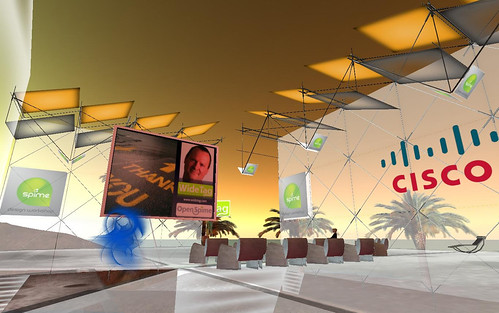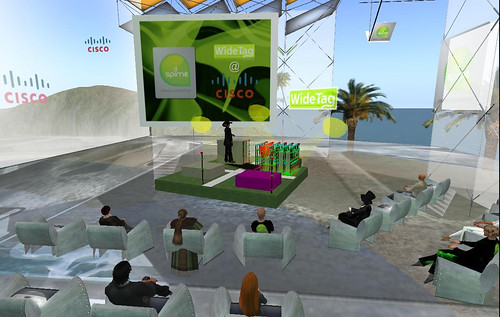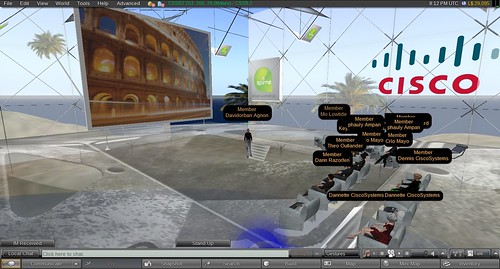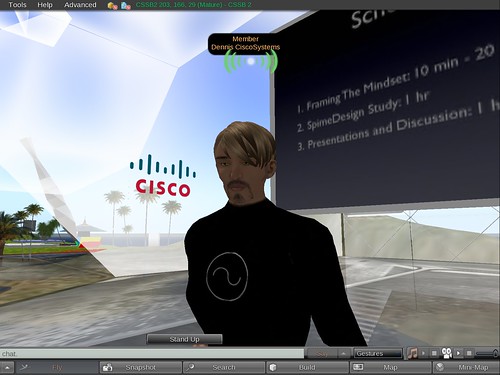![]()
I recently met David Orban, Chief Evangelist at WideTag who hosted and moderated the Spime Design Workshops at Cisco in Second Life. The concept of Spimes is still new to me, but I think David did a great job leveraging the virtual experience in running these workshops, which felt incredibly ‘real’ in a way – as though we were all together in the same room, even though we were all thousands of miles apart. In fact, I think this workshop was far more productive than the same event would have been in the physical world. It has a lot to do with the fact that the function of these workshops – teaching and 3D brainstorming – was perfectly suited to a virtual experience, and the group was well versed in how to use the virtual interface to communicate effectively. We were able to express and share ideas in realtime 3D, and it was an altogether inspiring experience.
I think groups of people with solid experience in using the full spectrum of tools at their disposal in a virtual world can achieve a heightened level of efficiency in communication that cannot be matched in the physical world. It goes beyond the notion of being as effective as physical interaction, and starts to become far more effective – and without the time and expense of long distance travel. These workshops were a perfect example of that.

We were divided into 3 groups, and I was paired with an architect and a biologist. As we discussed how Spime could be applied both architecturally and biologically, we developed and modelled a mesh of spimes that could be installed on a potential building site before design started – absorbing data about daylight, wind direction, wind speed, shadows from neighboring buildings, and more. The data could then be fed to a dashboard that absorbs, records, and displays the data to a designer. In fact, the data could be best visualized if it were ported to the virtual world in realtime. Perhaps it could even be fed to some kind of AI-enabled architectural form generator that could compliment or inform the architect’s work by proposing building forms that efficiently crystallize potential forms around that data, making the building hyper-efficient and hyper responsive to its site.
“Sounds a lot like what a tree does, only applied to a building,” someone commented. Mission accomplished! =)

It turns out there are quite a few examples already out there of concepts like this being applied – not only architecturally, but in artistic installations as well. It seems like a very ‘reflexive’ kind of architectural potential – taken to a whole new level.
A screenshot of the model we developed to describe the idea to the rest of the group is shown above.

Today, Dennis Mancini describes the workshops on the Cisco blog HERE. Here is a highlight:
“The caliber of some of the attendees representing Italy, Canada and various places around the U.S. was phenomenal. Several Cisco employees attended in real life while watching passively while others interacted virtually with their Avatars. During the live workshop some people came prepared in advance to discuss their ideas with prebuilt virtual Spime models and presentations for real world solutions for Social Sensor Spimes, I.E. Medical: tracking and finding the start of pandemic level viruses. Green: large scale granular aggregation Spimes by creating reflexive architecture for building towers that could dynamically change multiple user experiences on demand by altering it’s physical shape, leveraging its energy footprint as atmospheric conditions evolved.
Remarkably this was achieved virtually in SecondLife on the fly. We were most fortunate as the virtual environment accelerated the collaborative process furthermore by the array of professionals representing a cross section of disciplines from Designers, Art Directors, Software Coders, Architects, Analyst and Futurist. Also during the workshop, even though some attendees knew of each other had yet to meet in real life were leveraging their Social Capital with Web2.0 by also communicating live with many followers around the world on multiple Twitter, Blog, YouTube and other social media accounts.”
